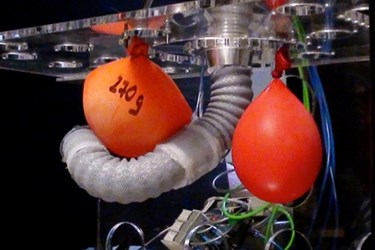New Multi-Tasking Surgical Tool Inspired by Octopus Tentacles

Inspired by the versatile motion capabilities of an octopus, researchers have developed a new tool that can bend, stretch, and change rigidity as required. Scientists say that the technology can perform more than one surgical function simultaneously, and it could facilitate less-invasive procedures.
A consortium of international research teams, coordinated by the Kings College London, have collaborated on the project, and recent improvements to the technology were added by a team in Italy, reported an article published by the Institute of Physics (IOP).
Much like an octopus tentacle, the device has no internal skeleton. Its cylindrical structure consists of two sections, or “arms,” with three chambers each. By pumping air into and out of each chamber, the device can be manipulated to bend and stretch around internal organs. Each section’s innermost chamber holds coarsely ground coffee that becomes packed together when air is vacuumed out, allowing operators to alter the device’s rigidity when necessary.
“Extensive characterization demonstrated that the proposed system is able to provide bending of almost 260 degrees and elongations up to 62 percent. Selective stiffening of more than 66 percent was measured, although the shape-locking functionality is not possible yet,” said authors of a study published in Bioinspiration & Biomimetics that tested the device’s ability to work around water balloons.
Researchers say the device’s two separate sections can perform independently, so one arm can hold back internal organs while the other arm operates on the target area.
“Traditional surgical tasks often require the use of multiple specialized instruments, such as graspers, retractors, vision systems and dissectors, to carry out a single procedure,” said the study’s lead author, Tommaso Ranzini of Sant’Anna School of Advanced Studies, in the IOP article.
Because this new device can perform a number of different functions simultaneously, the number of tools — and incisions — required to perform a procedure would be reduced.
“The concept has a great deal of potential and the implementation is clever,” Ravi Vaidyanathan, a senior lecturer in biomechatronics at Imperial College in London, told the BBC. However, he noted that the technology requires “refinement” before it could be viable in the operating room.
One such refinement will be reducing the device’s size. The current prototype is 14 cm long and 3 cm wide, relatively large for the keyhole work the device is intended to perform.
Kai Xu, robotics expert and assistant professor at the Shanghai Jiao Tong University, told Live Science that, while the technology represents a novel approach to minimally invasive surgery (MIS), researchers face considerable challenges with miniaturizing the device while maintaining structural integrity and maneuverability.
“The human body represents a highly challenging and non-structured environment, where the capabilities of the octopus can provide several advantages with respect to traditional surgical tools,” Ranzini said. “We believe this system will be the start for new and improved versions with more advanced features.”
Image source: Tommaso Ranzani et al
